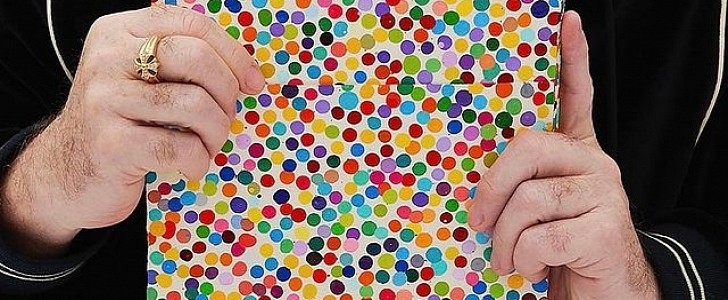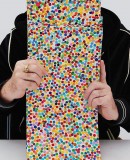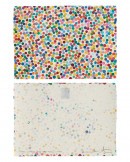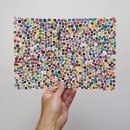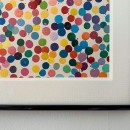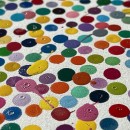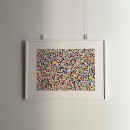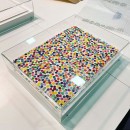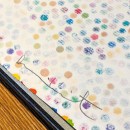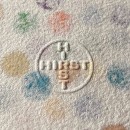No one said that the increased popularity of digital artworks in the form of NFTs should entail the destruction of their physical counterparts, but that’s not stopping many from doing just that. Artist Damien Hirst has joined the chat.
Damien Hirst is one of the highest profile artists in the UK, and also the richest (allegedly). He is known to challenge the status quo by openly inviting controversy, and he’s getting more than a share of it after taking his 2021 project The Currency into the next stage: the one in which he personally burns his own artworks, but after selling them to people.
The Currency is yet another take on the digital bubble of NFTs (non-fungible tokens) and cryptocurrency, and sees Hirst sell the 10,000 dot paintings he created in 2016 and sell them. Hirst has been making dot paintings for years, and they sell for anything between $800 and thousands of dollars. No two such paintings are alike, despite the fact that they might look the same at a first glance. Perhaps the strangest part about the appeal of these pieces is that Hirst famously has his assistants create them.
Announced in 2021, the sale designated future buyers at random, but each piece of art sold for $2,000 as a token. Then, the digital pieces were circulated on the second-hand market, with prices averaging over $20,000 and one NFT in particular selling for $176,000.
At the end of this stage, Hirst offered buyers the choice between the physical art work and its digital counterpart, saying that whichever was left would be destroyed. This week, at his London gallery, Hirst burned 1,000 physical pieces of the 4,851 not claimed for ownership. These were actually his own from the 10,000 units, which he never sold. He will continue to burn the physical versions of NFTs in the following days: every day at the same hour until October 30, Hirst will be destroying art. Physical paintings will die so NFTs will live.
Except that he’s not doing that, he says. The Currency is a discussion on the value of art and the ways in which it can be influenced – specifically its value. And he’s making a good point, because, as he was burning his iconic dot paintings, the value of the NFTs went up.
“A lot of people think I'm burning millions of dollars of art but I'm not,” Hirst says on his social media. “The value of art digital or physical, which is hard to define at the best of times, will not be lost, it will be transferred to the NFT as soon as they are burnt.”
The future is all-digital, and NFTs and crypto will be a part of it. Hirst is choosing to leave his imprint on this future by asking a very divisive question: does that mean art has to be exclusively digital?
The Currency is yet another take on the digital bubble of NFTs (non-fungible tokens) and cryptocurrency, and sees Hirst sell the 10,000 dot paintings he created in 2016 and sell them. Hirst has been making dot paintings for years, and they sell for anything between $800 and thousands of dollars. No two such paintings are alike, despite the fact that they might look the same at a first glance. Perhaps the strangest part about the appeal of these pieces is that Hirst famously has his assistants create them.
Announced in 2021, the sale designated future buyers at random, but each piece of art sold for $2,000 as a token. Then, the digital pieces were circulated on the second-hand market, with prices averaging over $20,000 and one NFT in particular selling for $176,000.
At the end of this stage, Hirst offered buyers the choice between the physical art work and its digital counterpart, saying that whichever was left would be destroyed. This week, at his London gallery, Hirst burned 1,000 physical pieces of the 4,851 not claimed for ownership. These were actually his own from the 10,000 units, which he never sold. He will continue to burn the physical versions of NFTs in the following days: every day at the same hour until October 30, Hirst will be destroying art. Physical paintings will die so NFTs will live.
Except that he’s not doing that, he says. The Currency is a discussion on the value of art and the ways in which it can be influenced – specifically its value. And he’s making a good point, because, as he was burning his iconic dot paintings, the value of the NFTs went up.
“A lot of people think I'm burning millions of dollars of art but I'm not,” Hirst says on his social media. “The value of art digital or physical, which is hard to define at the best of times, will not be lost, it will be transferred to the NFT as soon as they are burnt.”
The future is all-digital, and NFTs and crypto will be a part of it. Hirst is choosing to leave his imprint on this future by asking a very divisive question: does that mean art has to be exclusively digital?
